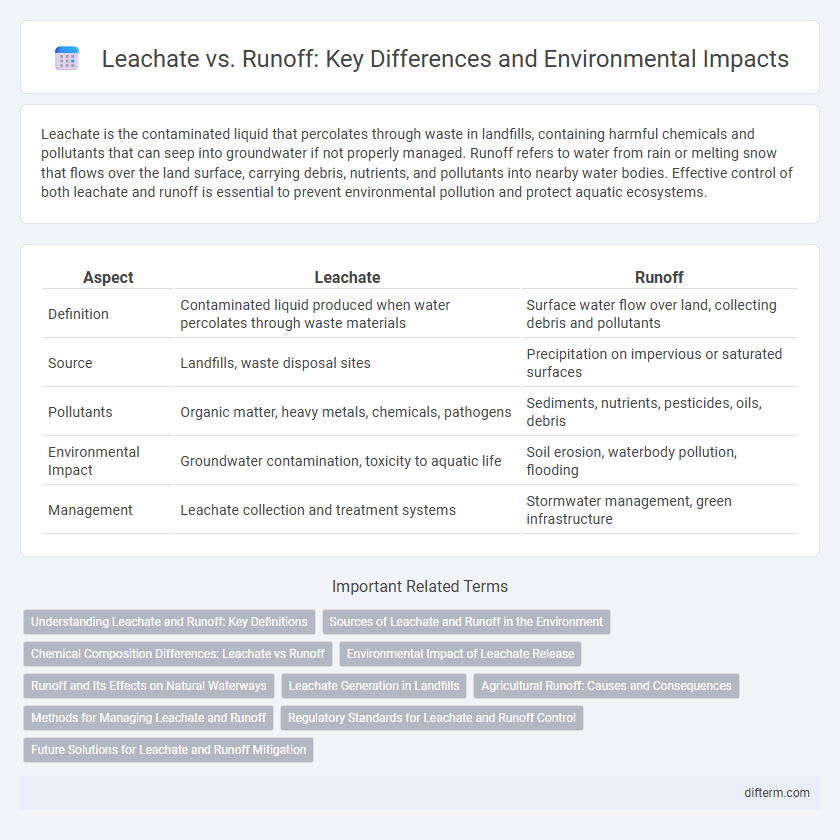Leachate is the contaminated liquid that percolates through waste in landfills, containing harmful chemicals and pollutants that can seep into groundwater if not properly managed. Runoff refers to water from rain or melting snow that flows over the land surface, carrying debris, nutrients, and pollutants into nearby water bodies. Effective control of both leachate and runoff is essential to prevent environmental pollution and protect aquatic ecosystems.
Table of Comparison
| Aspect | Leachate | Runoff |
|---|---|---|
| Definition | Contaminated liquid produced when water percolates through waste materials | Surface water flow over land, collecting debris and pollutants |
| Source | Landfills, waste disposal sites | Precipitation on impervious or saturated surfaces |
| Pollutants | Organic matter, heavy metals, chemicals, pathogens | Sediments, nutrients, pesticides, oils, debris |
| Environmental Impact | Groundwater contamination, toxicity to aquatic life | Soil erosion, waterbody pollution, flooding |
| Management | Leachate collection and treatment systems | Stormwater management, green infrastructure |
Understanding Leachate and Runoff: Key Definitions
Leachate is a contaminated liquid formed when water percolates through waste material, often carrying harmful chemicals and pollutants that can infiltrate soil and groundwater. Runoff refers to surface water flow that occurs when precipitation exceeds the infiltration capacity of the ground, potentially transporting pollutants into rivers, lakes, and oceans. Understanding the distinctions between leachate and runoff is crucial for effective waste management and water pollution control strategies.
Sources of Leachate and Runoff in the Environment
Leachate primarily originates from decomposing waste in landfills, where water percolates through the material, absorbing harmful chemicals and organic pollutants. Runoff is generated when precipitation flows over impervious surfaces like roads, parking lots, and agricultural fields, collecting sediments, nutrients, and contaminants. Both leachate and runoff contribute to environmental pollution by transporting toxins into soil and water systems, affecting ecosystems and water quality.
Chemical Composition Differences: Leachate vs Runoff
Leachate typically contains higher concentrations of heavy metals, nutrients like nitrogen and phosphorus, and organic compounds due to prolonged contact with waste materials, resulting in a complex chemical composition. Runoff primarily carries surface contaminants such as sediments, pesticides, and fertilizers, which vary depending on land use and rainfall intensity. The distinct chemical profiles highlight leachate's potential toxicity and environmental risk compared to the more variable and often lower concentration pollutants found in runoff.
Environmental Impact of Leachate Release
Leachate, a toxic liquid generated from waste decomposition in landfills, poses a significant environmental threat due to its high concentration of harmful chemicals and heavy metals contaminating soil and groundwater. Unlike runoff, which primarily carries surface pollutants, leachate infiltrates deep into the subsurface, leading to long-term ecosystem degradation and water quality impairment. Effective management and treatment of leachate are critical to preventing widespread contamination and protecting aquatic habitats and human health.
Runoff and Its Effects on Natural Waterways
Runoff occurs when rainwater or melted snow flows over the ground surface, carrying pollutants and sediments directly into natural waterways, disrupting aquatic ecosystems. It increases the risk of water pollution by transporting fertilizers, pesticides, oils, and heavy metals into rivers, lakes, and streams, leading to eutrophication and habitat degradation. Managing runoff through green infrastructure like permeable pavements and vegetative buffers helps mitigate its harmful effects on water quality and biodiversity.
Leachate Generation in Landfills
Leachate generation in landfills occurs when water percolates through waste layers, dissolving organic and inorganic contaminants and creating a toxic liquid. This leachate poses significant environmental risks by infiltrating soil and groundwater if not properly managed through engineered liners and treatment systems. Effective control of landfill leachate is essential to prevent pollution and protect surrounding ecosystems.
Agricultural Runoff: Causes and Consequences
Agricultural runoff primarily consists of excess water from irrigation or rainfall that carries pesticides, fertilizers, and sediments into nearby water bodies, causing nutrient pollution and eutrophication. Unlike leachate, which originates from decomposing waste in landfills and seeps through soil layers, agricultural runoff travels over the surface, directly impacting aquatic ecosystems and water quality. The accumulation of nitrogen and phosphorus in runoff accelerates harmful algal blooms and oxygen depletion, threatening biodiversity and human health.
Methods for Managing Leachate and Runoff
Effective management of leachate involves collection systems such as impermeable liners and sub-drainage networks to prevent groundwater contamination, while runoff is controlled through retention ponds, vegetative swales, and permeable pavements to reduce surface water pollution. Advanced treatment technologies for leachate include biological treatment, reverse osmosis, and chemical precipitation to remove toxic substances, whereas runoff management relies heavily on green infrastructure and stormwater management practices to mitigate sediment and nutrient loads. Both systems require continuous monitoring and maintenance to ensure environmental compliance and protect aquatic ecosystems from harmful pollutants.
Regulatory Standards for Leachate and Runoff Control
Regulatory standards for leachate focus on treating and containing hazardous contaminants to prevent groundwater and soil pollution, often requiring landfill liners and leachate collection systems. Runoff control standards emphasize minimizing sediment, nutrient, and pollutant discharge into surface waters through stormwater management practices like retention basins and vegetative buffers. Both frameworks mandate monitoring and reporting to ensure compliance with environmental quality criteria set by agencies such as the EPA and local environmental authorities.
Future Solutions for Leachate and Runoff Mitigation
Innovative membrane technologies and bioreactors are emerging as effective future solutions for leachate treatment, reducing toxic chemical leakage into groundwater. Advanced green infrastructure such as permeable pavements and vegetative swales optimize runoff management by enhancing natural infiltration and pollutant filtration. Integration of real-time monitoring systems with AI-driven predictive analytics will be pivotal in early detection and adaptive control of both leachate and runoff, minimizing environmental impacts.
leachate vs runoff Infographic

 difterm.com
difterm.com